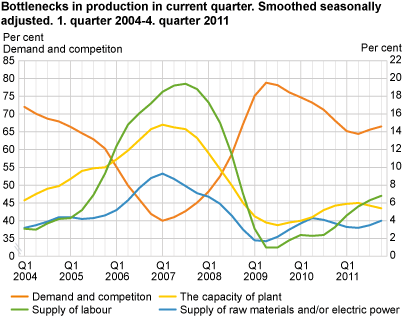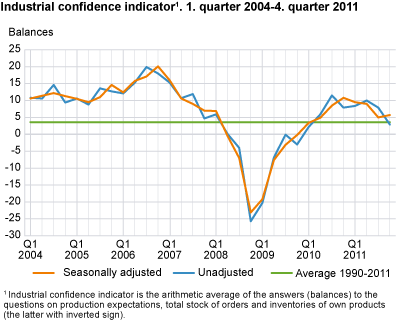Content
Published:
This is an archived release.
Sector differences
Norwegian industrial managers report a negative development in export markets. Improved demand in home markets compensates for some of this decline.
According to the business tendency survey, the Norwegian manufacturing industry experienced further growth in output, employment and home market prices in the fourth quarter of 2011. An increase in new orders received from home markets explains these results. The opposite occurred in export markets; prices fell and there was a decline in new orders received. The fall in demand was causing problems for sectors that depend on exports like basic metals and basic chemicals etc.
The number of working months covered by the current stock of orders is somewhat lower than in the previous survey, but the result was higher than the historic average for the manufacturing industry. Average capacity utilisation fell to 79.3 per cent in the fourth quarter of 2011. International comparisons of average capacity utilisation are available from EUROSTAT .
Prospects of further improvement in domestic markets
The general short-term outlook (Q1 2012) is considered to be positive. Prospects of improved conditions in domestic markets support this result. The industrial confidence indicator rose to 6 (seasonally-adjusted net figure) in the fourth quarter of 2011. International comparisons of the industrial confidence indicator are available from EUROSTAT (EU), the Swedish National Institute of Economic Research (Sweden) and Statistics Denmark .
Less employment within production of intermediate goods
Sectors producing intermediate goods (wood and wood products, paper and paper products, non-metallic mineral products, basic metals etc.) experienced a decline in employment. Poor development in prices and new orders received in export markets explains this development. Total output continued to rise, but the growth in demand was weaker than in the first six months of 2011. A similar tendency is recorded for new orders received in domestic markets. Average capacity utilisation fell to 80.5 per cent in the fourth quarter of 2011. The number of working months covered by the current stock of orders is somewhat lower than in the previous survey.
The general short-term outlook (Q1 2012) is considered to be positive, but optimism is waning and investments seem to be falling.
Higher employment within production of capital goods
Sectors producing capital goods (machinery and equipment, ships, boats and oil platforms, repair and installation etc.) experienced higher output and strong growth in employment. However, a lack of qualified labour stunted the growth in production. There was a further increase in new orders received, but the growth in demand was weaker than recorded in the first six months of 2011. Prices fell in export markets and improved in domestic markets. Average capacity utilisation is estimated at 81.6 per cent in the fourth quarter. This result lies below the historic average for the industries in question. The number of working months covered by the current stock of orders is more or less the same as in the previous survey.
The general short-term outlook (Q1 2012) is considered to be positive, and the investments seem to be growing. Prospects of further improvement in output and new orders received explain these results.
Still high demand for consumer goods
Sectors producing consumer goods (food products, printing and reproduction, basic pharmaceuticals, furniture etc.) experienced higher output, moderate growth in employment and improved market prices. High demand for food products and beverages partly explains this development. Average capacity utilisation is estimated at 75.5 per cent in the fourth quarter of 2011.
The general short-term outlook (Q1 2012) is considered to be positive. Prospects of improved conditions in home and export markets support this view.
| Industry | Prospects | Background | |||||||||||||||||||||||||||||||||||||||||||||||||||||||||||||||||||||||||||||
|---|---|---|---|---|---|---|---|---|---|---|---|---|---|---|---|---|---|---|---|---|---|---|---|---|---|---|---|---|---|---|---|---|---|---|---|---|---|---|---|---|---|---|---|---|---|---|---|---|---|---|---|---|---|---|---|---|---|---|---|---|---|---|---|---|---|---|---|---|---|---|---|---|---|---|---|---|---|---|---|
| Food, beverages and tobacco | ++ | Growth in output and employment. Increase in demand from the domestic market. Rise in market prices, The general outlook for Q1 is considered to be better. Expectations of further growth in output, demand from the domestic market and market prices. | |||||||||||||||||||||||||||||||||||||||||||||||||||||||||||||||||||||||||||||
| Wood and wood products | + | Higher levels of production and capacity utilisation. Rise in new orders from the domestic market, while new orders from the export market have declined. Higher market prices in the domestic market, while export prices are down. Many mangers judge the general outlook for Q1 as better, and further growth in output and new orders are expected. Domestic market prices are expected to rise. | |||||||||||||||||||||||||||||||||||||||||||||||||||||||||||||||||||||||||||||
| Paper and paper products | - | Growth in output. Reduced employment, new orders and market prices. The general outlook for Q1 is judged as worse by many managers. This view is supported by expectations of reduced level of new orders and lower market prices.. | |||||||||||||||||||||||||||||||||||||||||||||||||||||||||||||||||||||||||||||
| Basic chemicals | -- | Output, capacity utilisation and employment are reduced. Decline in new orders from the domestic and export markets. Lower market prices . The general outlook for Q1 is considered as poor, and further reductions in production, employment, new orders and market prices are expected. | |||||||||||||||||||||||||||||||||||||||||||||||||||||||||||||||||||||||||||||
| Non-ferrous metals | - | Decline in output, capacity utilisation and employment. Reduced levels of new orders and market prices. Many managers report poor demand from the export market as a limiting factor for production. The general outlook for Q1 is considered negative, but fewer managers share this view than in the previous survey. The level of production is expected to be more or less unchanged, while new orders and market prices are expected to decline. | |||||||||||||||||||||||||||||||||||||||||||||||||||||||||||||||||||||||||||||
| Fabricated metal products | + | Many managers report higher levels of production and capacity utilisation. Employment and new orders from the domestic market have increased. More or less unchanged level of domestic market prices, while export prices are reduced. The general outlook for Q1 is considered as better, and further growth in output and new orders are expected. Expectations of rise in domestic market prices. | |||||||||||||||||||||||||||||||||||||||||||||||||||||||||||||||||||||||||||||
| Computer and electrical equipment | -(+) | More or less unchanged level of production. Increase in employment. Decline in new orders and market prices. Many managers report poor demand as a limiting factor for production. The general outlook for Q1 is considered more or less unchanged. There are expectations of growth in output, employment and new orders from the domestic market. Export market prices are expected to fall. | |||||||||||||||||||||||||||||||||||||||||||||||||||||||||||||||||||||||||||||
| Machinery and equipment | ++ | Many managers report higher levels of production, capacity utilisation and employment. Increase in new orders from the domestic market, while the level of new orders from the export market is more or less unchanged. Export prices are reduced. The general outlook for Q1 is considered positive by many mangers, and further rise in output, employment an new orders are expected. | |||||||||||||||||||||||||||||||||||||||||||||||||||||||||||||||||||||||||||||
| Ships, boats and oil platforms | + | Higher levels of production, capacity utilisation and employment. The level of new orders is more or less unchanged. The average number of working months covered by the current stock of orders is somewhat reduced. Planed investments have increased, and the general outlook for Q1 is considered positive by many managers. Output, employment and new orders are expected to increase in forthcoming quarter. Export prices are expected to decline. | |||||||||||||||||||||||||||||||||||||||||||||||||||||||||||||||||||||||||||||
| Repair, installation of machinery | + | Growth in output, capacity utilisation and employment. New orders from the domestic and export markets have increased. Domestic market prices are higher, while export prices are reduced. Planed investments have increased, and the general outlook for Q1 is judged to be improving. Output, employment and new orders are expected to increase. Further growth in domestic market prices are expected, while export prices are expected to fall. | |||||||||||||||||||||||||||||||||||||||||||||||||||||||||||||||||||||||||||||
| The column for Prospects shows an overall evaluation of the present situation and expected short-term developments using the symbols + and -. The following codes and constellations are used: |
++
+ ² - -- +(-) +/- |
Very good
Good Stable Poor Very poor Good, but with certain negative indications A situation where the + and - factors even out. |
|||||||||||||||||||||||||||||||||||||||||||||||||||||||||||||||||||||||||||||
Industrial confidence indicator (ICI)The indicator is the arithmetic average of the responses (balances) to the questions on production expectations, total stock of orders and inventories of own products (the latter with an inverted sign). The indicator is a guide to the level of industrial production since:
TimelinessThe survey data was collected in the period between 10 December 2011 and 25 January 2012. |
Changes in the Business tendency surveyThe questionnaire used to collect data for the Business tendency survey changed as from the survey for the 4th quarter of 2011. The new questionnaire has been thoroughly tested, and there has been a special focus on making the questions easier to understand. Some questions have been replaced. The following questions have been removed from the new questionnaire, and are therefore no longer published: Time of delivery for the total stock of orders Inventories of raw materials, semi-finished products etc. Stocks of raw materials compared to current level of production Stocks of own products compared to the value of sales The new questionnaire includes questions on prices on input factors, profitability and limiting factors for investments in fixed assets. New indicators will be published when they are quality assured, and when we have results for some consecutive quarters. Apart from these changes the questions are the same as in the old questionnaire. |
Additional information
The statistics provide current data on the business cycle for manufacturing, mining and quarrying by collecting business leaders’ assessments of the economic situation and the short term outlook.
Contact
-
Edvard Andreassen
E-mail: edvard.andreassen@ssb.no
tel.: (+47) 40 90 23 32
-
Ståle Mæland
E-mail: stale.maeland@ssb.no
tel.: (+47) 95 05 98 88


